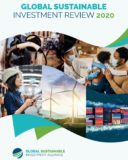The Global Sustainable Investment Alliance (GSIA) is pleased to release its biennial Global Sustainable Investment Review, revealing an industry that has grown to US$35.3 trillion as it transitions to one more focused on the short- and long- term impacts generated by investors.
In its fifth edition, the biennial Global Sustainable Investment Review 2020 maps the state of sustainable and responsible investment of major financial markets globally, combining regional data from the United States, Canada, Japan, Australasia and Europe. This year’s report shows the continuing prevalence of sustainable investment across the global investment industry, with assets under management reaching US$35.3 trillion, a growth of 15% in two years, and in total equating to 36% of all professionally managed assets across regions covered in this report.
The report outlines the state of the sustainable investment industry based on the globally recognised sustainable investing definitions, as used globally and developed by the GSIA members. These definitions were revised in October 2020 to reflect the most up-to-date practice and thinking in the global sustainable investment industry. ‘Sustainable investment’ , as referred to in the report, is a term that is inclusive of investment approaches that consider environmental, social and governance (ESG) factors in portfolio selection and management across seven strategies of sustainable or responsible investment (as detailed in the ‘Defining Sustainable Investment’ section).
For the purpose of articulating our shared sustainable investment work in the broadest way, GSIA uses this inclusive definition, recognising there are distinctions and regional variations in its meaning and use, and related or interchangeable terms such as responsible investing and socially responsible investing.
The report shows that beyond the top line growth in sustainable investment assets, this is an industry that is in transition, with rapid developments across regions that are reshaping sustainable investment to increasingly focus on moving the industry towards best standards of practice. Increasingly, there are expectations that sustainable investment is defined not just by the strategies involved, but by the short- and long-term impacts that investors are having from their sustainable investment approach.
This transition is playing out differently in different regions, and this report includes a regional highlights section that provides deep insights into the different paths that various regions are now taking and the distinct drivers behind these changes. This transition is leading to variations in the scale and growth of sustainable investment in different regions. In this 2021 report, many regions continue to see strong growth in sustainable investment assets under management – most notably Canada, the United States and Japan. Other regions are slowing down their rate of growth or have seen a reported reversal – in particular Europe and Australasia. In both cases, this is largely due to changes in how sustainable investment is defined, either by law as in the case of the EU or by new industry standards as is the case in Australasia.
This report maps out these global and regional distinctions in the evolution of sustainable investment, articulated in both the data presented, but also in the regional narrative summaries.
This report includes additional market insights from China, Latin America, Africa, the United Kingdom and other areas of Asia, all showing unique markets for sustainable investment.
Key findings in this year’s report include:
- At the start of 2020, global sustainable investment reached USD35.3 trillion in five major markets, a 15% increase in the past two years (2018-2020).
- Sustainable investment assets under management make up a total of 35.9% of total assets under management, up from 33.4% in 2018.
- Sustainable investment assets are continuing to grow in most regions, with Canada experiencing the largest increase in absolute terms over the past two years (48% growth), followed by the United States (42% growth), Japan (34% growth) and Australasia (25% growth) from 2018 to 2020. Europe reported a 13% decline in the growth of sustainable investment assets in 2018 to 2020 due to a changed measurement methodology from which European data is drawn for this year’s report. This reflects a period of transition associated with revised definitions of sustainable investment that have become embedded into legislation in the European Union as part of the European Sustainable Finance Action Plan.
- Canada is now the market with the highest proportion of sustainable investment assets at 62%, followed by Europe (42%), Australasia (38%), the United States (33%) and Japan (24%).
- The United States and Europe continue to represent more than 80% of global sustainable investing assets during 2018 to 2020.
- The most common sustainable investment strategy is ESG integration, followed by negative screening, corporate engagement and shareholder action, norms-based screening and sustainability-themed investment.
The Global Sustainable Investment Review 2020 was made possible through the generosity of report sponsors RBC Global Asset Management and Robeco.




